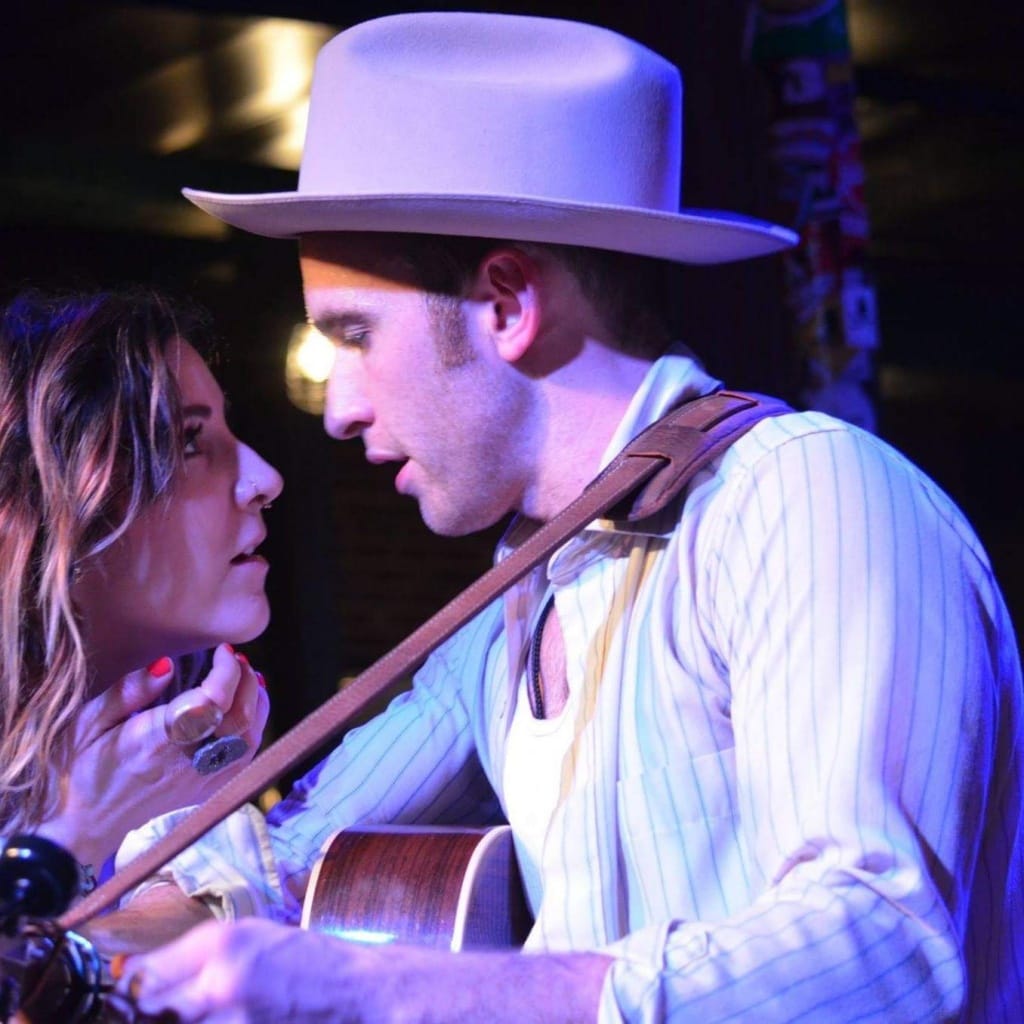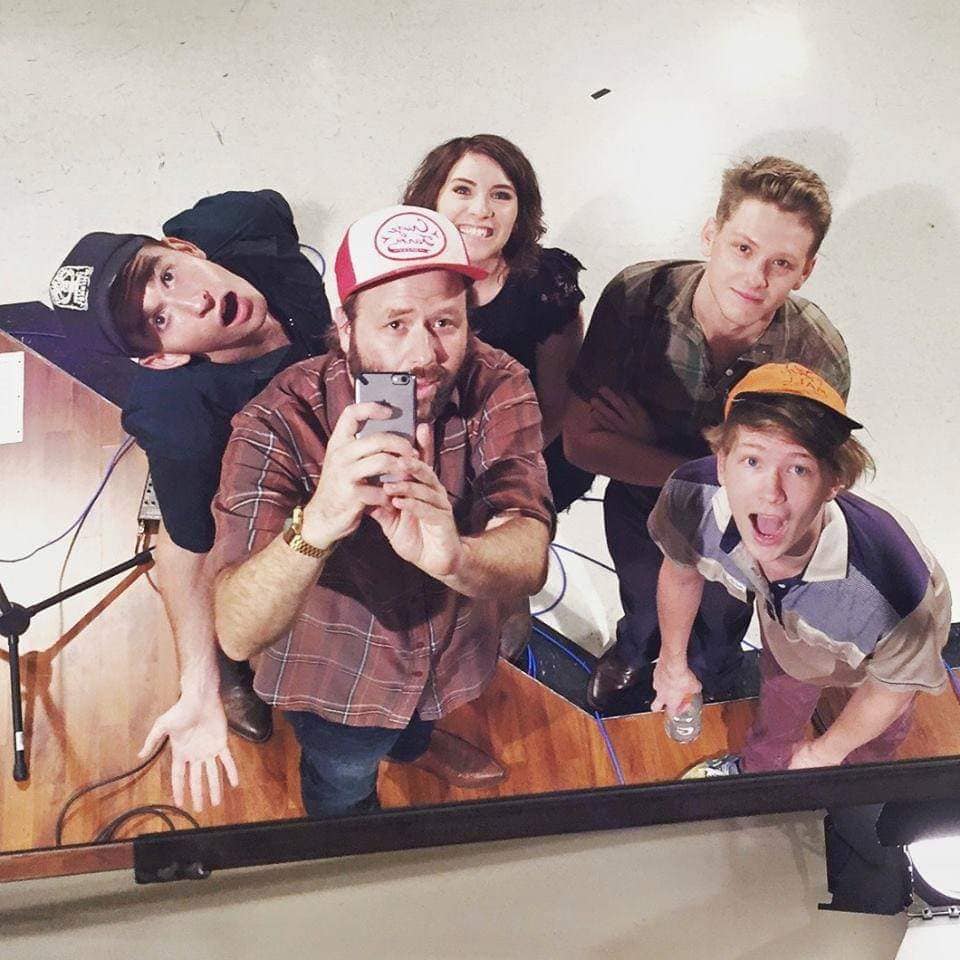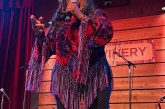
“Come all without/
Come all within/
You’ll not see nothing like…”
-Bob Dylan
Local Americana legend Sam Quinn grinned, surveying the crowd. The founding member of the everybodyfields and bassist/vocalist for The Black Lillies had just ambled, drink-in-hand, onto the crowded stage at the Outpost on Saturday, March 30, to casually welcome the capacity crowd to the pop-up venue’s final performance. However, in spite of his celebrity status among locals, Quinn’s quiet introduction was a bit at odds with a room that was bursting at the seams with anticipation.
To fans charting the trajectory of the local roots scene over the past decade, it felt like Quinn might be onstage in an official capacity: to give a type of blessing, to symbolically pass a torch by way of introducing the band that in recent years has filled the void his own everybodyfields left to become the new standard-bearer of harmony-drenched, psychedelically rocking Americana in East Tennessee. That band, Guy Marshall, was on hand to celebrate “The Love We’ve Made and Otherwise,” their hotly anticipated, long-awaited follow-up to their 2015 debut, “Depression Blues.”
Perhaps it was too much to expect the notoriously understated Quinn to hail and loudly proclaim the arrival of the lushly layered, mature sophomore effort, but anyone in attendance that night can attest to the power of the now-mighty Guy Marshall. In terms of taking risks – in living, writing, creating art and presenting the live show they’re capable of – the band is at the forefront of the local scene, and Knoxville crowds really haven’t seen anything like what they’re doing these days.
“We were blazing through those songs,” lead singer and songwriter Adam McNulty says about the set at the Outpost. He credits the recent additions of Gamenight and MEOB indie-rocker Josh Manis on electric guitar and longtime friend Jonathan Keeney rejoining the group on steel guitar after a stint with The War and Treaty for the added rocked-up effect at the release show.
“We ended up playing them in different ways because the group keeps changing,” he says. “These guys, they make it way better.”
Guy Marshall’s look and sound convey the image of a psychedelic indie-rock band and a countrified honky-tonk group colliding on the way to separate gigs and taking the less-totaled car together to one show to combine forces, creating one uber-band with beautiful and wonderfully confusing genre-blending powers.
Adam and his wife Sarrenna sing folky ballads with lonesome, yearning harmonies over an acoustic base that Keeney will fill in with emotive lap-steel swells, while Manis, lead guitarist Eric Griffin, bassist Travis Bigwood and drummer Zac Gilleran (the latter two also performing with Dakota Smith in Sweet Years) crash in with jagged, rumbling, thumping and spacey effects-driven, rhythmic and atmospheric waves of accompaniment. The result is a euphoric sea that ebbs and flows, full of crashes and hard stops for McNulty to wave his hands, big-tent-revival-preacher style, over as he squeals the hooks before everything clatters down hard once again.
There’s also been quite the buzz around the risque and artistically risk-taking cover art of the new album, shot by Brandon Langley with Mistakist Productions and conceptualized by Langley and the McNultys.
On the cover, the camera shoots from outside the corner unit of a neon-lit stucco economy motel. Through foggy glass, Sarrenna stands, washing in the nude, barely covered in suds in the tub, bathed in incandescent magenta light. Adam, standing outside in the late-night air, looks pensively from the walkway at the adjacent window. Hat in hand and with blood and dirt besotting his clothes, he appears as though he’s been through a rough night and is hesitant to return to the room and disturb his lover’s peaceful repose. He peers into the room, forlorn, unsure as to whether he should enter.
“Do I knock?” McNulty says, regarding the predicament depicted in the image. It’s symbolic, he says, of “having a barrier but still being together.” Also, he says of Sarrenna, “She treats herself better and always has.” On the back of the album, the two reach for each other midair after being propelled out of colliding vehicles that are smashing each other to bits below them.
Guy Marshall have become the darlings of the Americana scene since emerging a little more than six years ago, taking the mantle of the exciting new kids on the block in the wake of the everybodyfields’ breakup and The Black Lillies spending more time on the road. WDVX spun “Depression Blues” constantly and invited them to every event – “Blue Plate Special,” Camperfest and more – they sponsor, and they were plugged into the regional circuit with events such as Bristol Rhythm ‘N’ Roots. (They’re no strangers to events associated with this publication, either, having made appearances at BLANKFest and last year’s inaugural Second Bell Music Festival.)
Like the everybodyfields before them, sometimes the tension between the couple at the helm is evident and can create beautifully risky, flirty, dangerous fun – the kind of which that keeps audiences on the edge of their proverbial seats waiting to see what happens next. And when the two seem uncomfortable with each other onstage, those cringeworthy moments can feel almost unbearable for anyone watching them suffer through them – until the band rips right back into the next rocking number and they transform the negative energy into musical gold.
To be sure, those lyrical and situational moments are borne out of real-life issues. Adam admits that his partying proclivities and his manic tendency to overdo and overshare have created strains in their relationship. “I go back and forth, and I do quite a bit of silly things,” he says. “And I do romanticize it, for sure.” “I Don’t Try” is a newer, personal song, he says that explores “mistakes I had made.”
Another track the band has been road-testing around the region for about a year now is “Hard Times,” which documents the literal seasonal depression the couple experiences in winter and the figurative winter of their relationship – the tumultuous times they encounter in their relationship. The band uses the number as catharsis, often opening shows with the song in which Adam confesses that they almost weren’t sure they’d make it.
Still, it’s hard to miss the constant underlying sweetness evident in the couple’s rapport, in their voices and glances at one another and in Adam’s songwriting – and as he talks in the interview for this article about the long and winding road of their relationship. It’s no surprise to learn that they got together when they were just teenagers. Even when they argue, he says, they can be each other’s most ardent defenders and supporters. Concerning the cover shoot, he says of Sarrenna, “She was really brave to do that” before mentioning arguments with their families about it in which he defended her honor.
The band chose to bookend the album with positive love songs “The Love” and “The Night We Lay Down,” both of which highlight where they are now in their journey together. The middle comprises a mix of songs that detail the difficult journey. Two of those tracks, “County Fair” and the lead single “West Virginia,” are older songs that date back to the “Depression Blues” era. They are excellent examples of the storytelling style embodied in country and Americana music, and they’ve always wanted to get around to recording them.
However, the lyrical and stylistic differences between those songs and the rest of the album highlight and bring into stark contrast for this reporter what’s been discussed on countless other reviews of local and national artists upon the release of their second and third albums: The tendency of a band on its first release (particularly in the country world) is to play off its influences, familiar genre tropes and style templates.
But as the band plays together for years and its members live real adult lives and explore personal relationships, the following records roll off much more smoothly and naturally. The lyrics sound less like practiced, made-up stories about romanticized country characters; instead, the songs become more about the real lives the writers are living, they are emotive in an authentic and natural way and the instrumentals feel less tight, as well, sweeping along with the song. The dynamic comes across just as effortlessly in a live setting, too. Such is the case with Guy Marshall.
“I really used to [write to the genre] a lot,” Adam agrees, using as an example how he started out writing about the stories of the band’s namesake, his late grandfather and his epic life story. “He had a pretty interesting, pretty wild story,” he says, acknowledging the reason behind his initial inspiration.
Those songs can be very interesting exercises in storytelling that draw people in, but the developing theory – and the emerging story of Guy Marshall – concerns those subsequent records when the songwriter is just spilling out his or her truth about love and life. The songs become so much more universally relatable that a tipping point is achieved where the songwriter and band are pushed into a territory where fans really are falling in love with them.
Religion also was big topic early on for Adam. “Coming to terms … resolving all of that” was difficult, he says. “I pretty much hated religion fervently. I had a lot of funny experiences.” He talks of growing up in a nondenominational church and relates stories like being kicked out of the praise band because he wouldn’t throw his secular CDs into a trash barrel to be burned along with the rest of the group’s. His brother did, he says, later regretting the move and trying to sneak back to salvage some of the discs.

Adam says that he and Langley had an interesting experience on the other side of it recently, seeing a church even wilder than his when researching a potential video shoot idea. They visited a backwoods church in Kentucky famous for snake-handling and arsenic-eating amongst its congregation. He mentions that they happened to be there by accident on the anniversary of the death of the former preacher, who hadn’t survived a bite by a poisonous asp.
At one point, Adam says, as Guy Marshall gained steam, the McNultys and the band were gung-ho about the idea of going for the bigtime – or at least the long-haul road lifestyle of taking their act out on the highways for good. As he’s wrestled with and conquered some of his own personal demons, though, he says that he’s found that he likes to further his self-development through work, school, his relationship and conventional routine like having the same place to lay his head most nights.
“It’s so glorified to kinda be a bit of a rat,” Adam says of the typical tour lifestyle. “At the same time, I kinda like being a bit of a rat,” he laughs. “But I want to do it for the reason of creating art.”
And that’s not to mention the successful projects of the band’s other members that spreads them out. Bigwood and his Mourning Doves have been putting out gorgeous singles and videos, and they recently played the famous Bluebird Cafe in Nashville behind his sparse, harmony-driven folk songs. Griffin has put out multiple psychedelic/folk-country solo releases. And Gilleran along with Bigwood (Sweet Years) and Manis (Gamenight, MEOB) are in some of the most popular indie bands in town.
Guy Marshall continues to refine, build and grow, but a lot of the journey the band – and Adam in particular – seems to have been on is learning to grow as humans and forgive themselves and others for past misdeeds. Adam again mentions the bookending on the new album as “it’s-all-gonna-be-OK songs … the beginning-but-end-at-the-same-time kinda song.” He thinks it’s alright for them to forgive themselves for being young and move on to the next phase of their lives and their art.
“We were too young to understand any of this [stuff],” he says.







